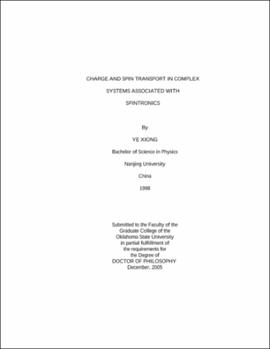| dc.contributor.advisor | Xie, Xincheng | |
| dc.contributor.author | Xiong, Ye | |
| dc.date.accessioned | 2013-11-26T08:26:38Z | |
| dc.date.available | 2013-11-26T08:26:38Z | |
| dc.date.issued | 2005-12 | |
| dc.identifier.uri | https://hdl.handle.net/11244/6920 | |
| dc.description.abstract | Scope and Method of Study: The purpose of this study was to explore charge and spin transport in several complex systems associated with spintronics. A distinct conductivity exponent observed at the percolation transition point in some colossal magnetoresistance (CMR) materials was studied by a real-space-renormalization method and numerical calculations. We also investigated the low temperature transport properties in a two dimensional electronic system coupled with phonons. After this, we studied spin entanglement effect between itinerant and localized electrons in a short one dimensional chain with low Fermi energy. | |
| dc.description.abstract | Findings and Conclusions: The distinct conductivity exponent could be understood by the concurrent occurrence of percolation transition and magnetic transition. The observation of exponent variance by a factor of 3 with or without external magnetic field could be well explained in our study. As to the second problem, we found the distribution of phonons near zero temperature departed from the Boson distribution because the entangled states were preferred from the energy point of view. This led to the low-temperature saturation of the variable range hopping of electrons and the existence of a metal-like behavior in two dimensions. Finally, in Quantum Point Contacts (QPC), as long as the entanglement between itinerant and localized electrons was maintained, a 3/4 quantum conductance occurred due to the blockade for the singlet state but not on the triplets. This would result in an observation of conductance near "0.7". We found that this blockade effect was complete as the effective coupling between itinerate and localized electrons exceeding a threshold. The many-body correlation of electrons near the band edge reduced this accessibility at low temperature and caused specific temperature dependence of the conductance. These results provided a natural explanation for the "0.7 anomaly" in QPC. | |
| dc.format | application/pdf | |
| dc.language | en_US | |
| dc.rights | Copyright is held by the author who has granted the Oklahoma State University Library the non-exclusive right to share this material in its institutional repository. Contact Digital Library Services at lib-dls@okstate.edu or 405-744-9161 for the permission policy on the use, reproduction or distribution of this material. | |
| dc.title | Charge and spin transport in complex systems associated with spintronics | |
| dc.contributor.committeeMember | Mintmire, John | |
| dc.contributor.committeeMember | Westhaus, Paul A. | |
| dc.contributor.committeeMember | Zhang, Weili | |
| osu.filename | Xiong_okstate_0664D_1542.pdf | |
| osu.accesstype | Open Access | |
| dc.type.genre | Dissertation | |
| dc.type.material | Text | |
| thesis.degree.discipline | Physics | |
| thesis.degree.grantor | Oklahoma State University | |
